George Washington was a fascinating and inspiring figure, one of the most famous in American history. While there’s much to admire about our first president, it’s important to remember he was also a man formed by his place and time. He owned enslaved people, believed in “assimilation” for Native Americans, and failed miserably in his early military endeavors. Explore these fun facts about George Washington to learn more.
Get your free Google Slideshow featuring all the fun facts below about George Washington!
20 Fun Facts About George Washington for Kids
1. George Washington was born on February 22, 1732, on a plantation in Virginia.
Washington was the fifth of nine surviving children from his father’s two marriages. He had three brothers, two sisters, three half-brothers, and one half-sister.
2. When Washington was 11, his father died and left George 10 enslaved people in his will. Washington owned hundreds of enslaved people throughout his life.

At the time of his death, Washington’s Mount Vernon plantation housed 317 enslaved people. In his later years he favored a gradual legislative end to slavery, and he left instructions in his will for his enslaved people to be emancipated (freed) upon his wife Martha’s death.
3. Washington had very little formal schooling—about the equivalent of an elementary school education today—a fact that embarrassed him.

Though his older brothers were sent to England for their education, Washington didn’t enjoy this privilege. After his father’s death when George was 11, he was kept at home to learn to run the plantation.
4. At 16, Washington left home to become a land surveyor. When he was 21, he was sworn in as a major in the militia, and in 1754 he led an attack that helped spark the French and Indian War.
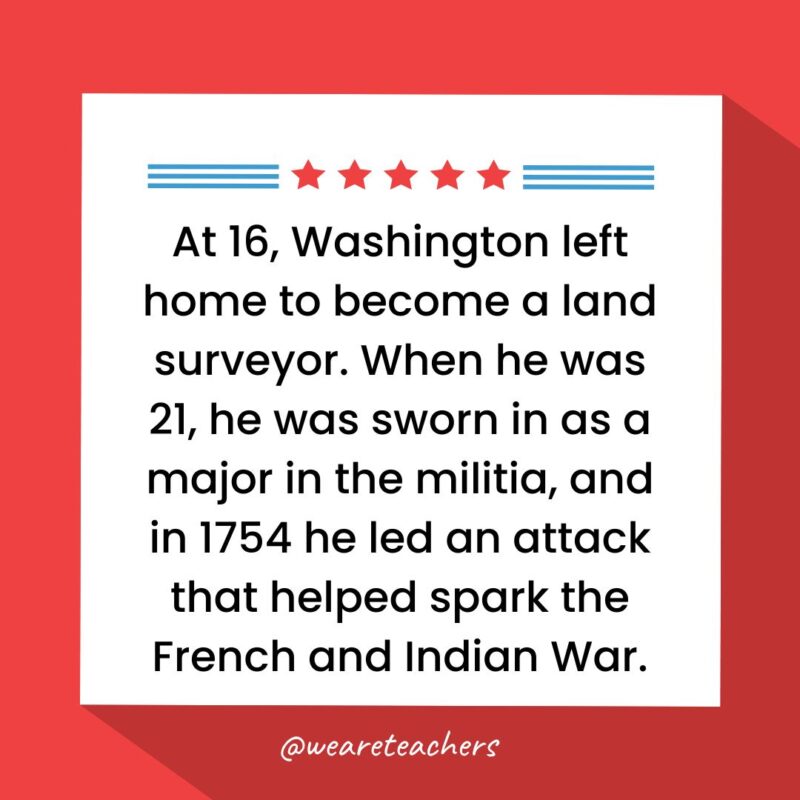
In 1758, Washington resigned his commission to return to work on his plantation lands. He was a brigade commander in charge of Virginia’s frontier defenses at the time of his resignation.
5. One of Washington’s earliest battles was an embarrassing failure. At Fort Necessity, his errors resulted in the death and injury of more than 100 men and the complete surrender of the fort.

Washington built the fort in a poor location prone to flooding, then miscalculated his enemy’s intentions. The surrender took place on July 4, 1754. Washington commanded 283 men at Fort Necessity, which means that more than one-third of his troops were wounded or killed.
6. In 1758, Washington was elected to the Virginia House of Burgesses, in which he served until 1776.
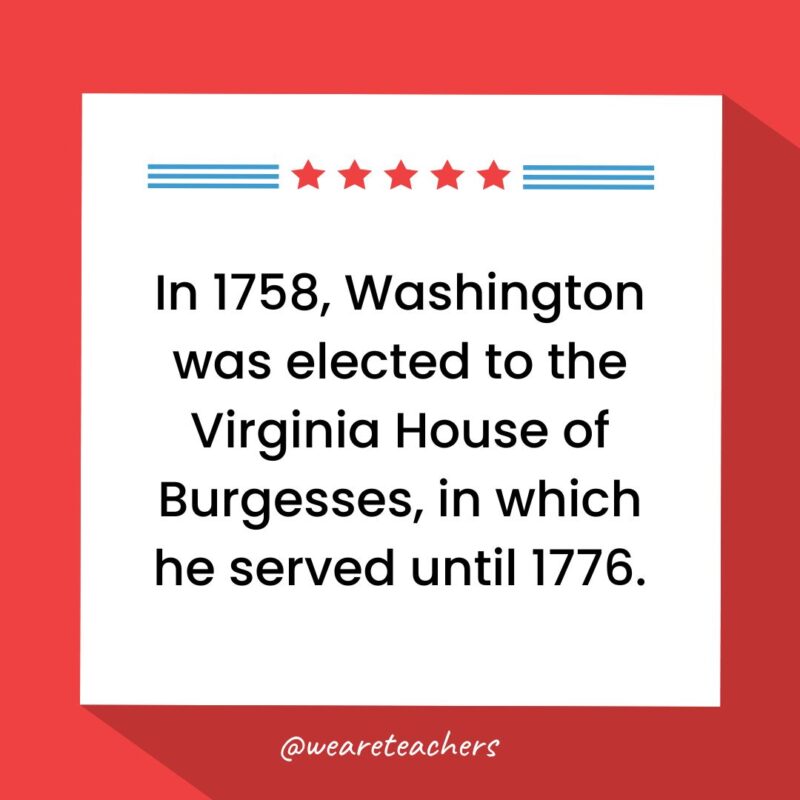
Washington first ran for the House of Burgesses in 1755, while he was still serving as a soldier—and lost. He received 40 votes, while his opponents received 270 and 271.
7. George Washington married Martha Custis in 1759. Martha was a widow with two young children. She and George never had children of their own.
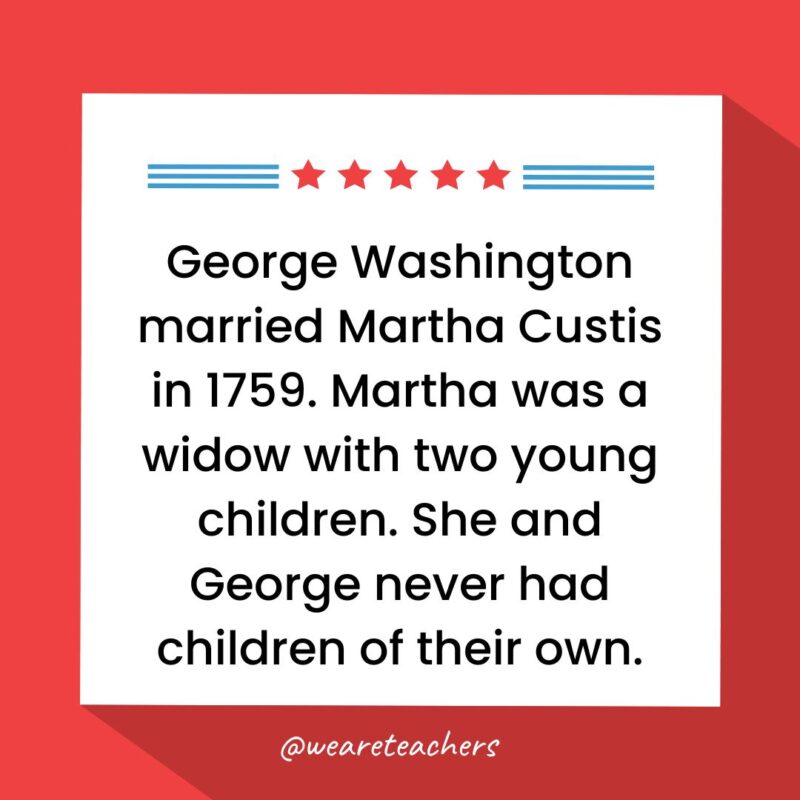
Martha was eight months older than George. She could read and write, which was somewhat unusual for women at the time. At the time of her second marriage, she was a wealthy woman with a great deal of land and nearly 300 enslaved people.
8. Mount Vernon in Virginia was George Washington’s home, on land that was granted to the family in 1674.

Mount Vernon grew tobacco and wheat, along with fruits and vegetables. The plantation doubled in size under Washington’s oversight to about 7,600 acres, while the house grew from 3,500 square feet to more than 11,000 square feet. The plantation was located on the ancestral lands of the Piscataway people.
9. Washington was an expert rider and enjoyed horse racing. He also bred mules using a donkey sent to him by King Charles III of Spain.

The donkey, known as Royal Gift, made big news in Revolutionary War–era America. The animal landed in Boston, and a Mount Vernon overseer spent 25 days walking it all the way to Virginia.
10. In 1775, the Second Continental Congress created the Continental Army and asked Washington to serve as commander in chief.
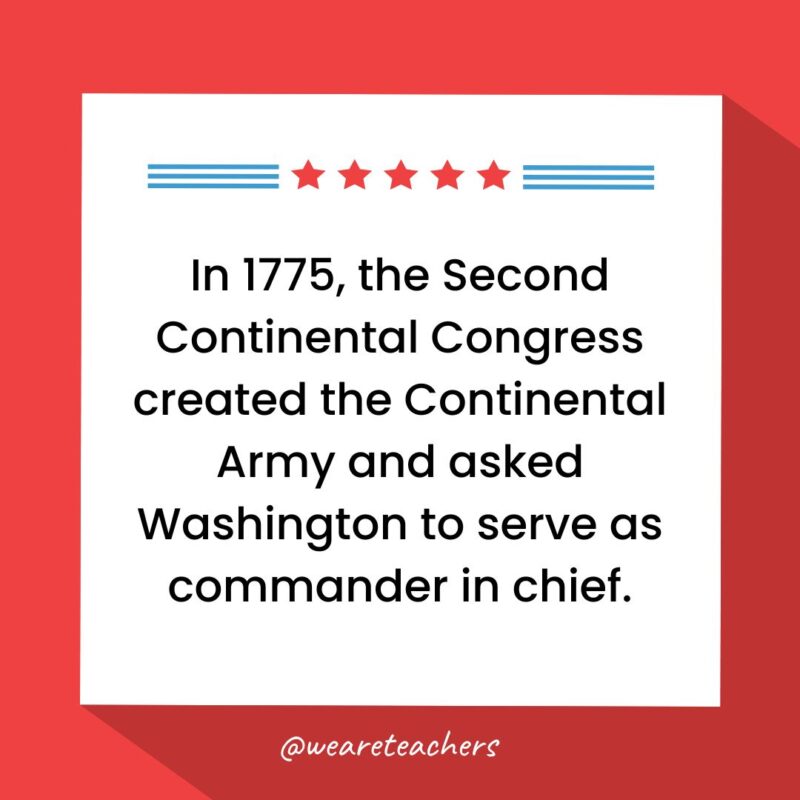
Washington refused to take a salary for commanding the army, only accepting the costs of his expenses such as room and board.
11. Over six years, Washington famously remained with his underfunded, undertrained troops in even the harshest conditions, such as the winter spent at Valley Forge.

At the start of that well-known winter, Washington estimated that one in three of his soldiers didn’t even have shoes, much less warm clothing. They also had almost no food to feed the troops. Despite that, Washington spent the winter training his men, emerging stronger than ever in the late spring to continue their fight.
12. Washington returned to Mount Vernon after the war, but was called back into public life as president of the Constitutional Convention in 1787.
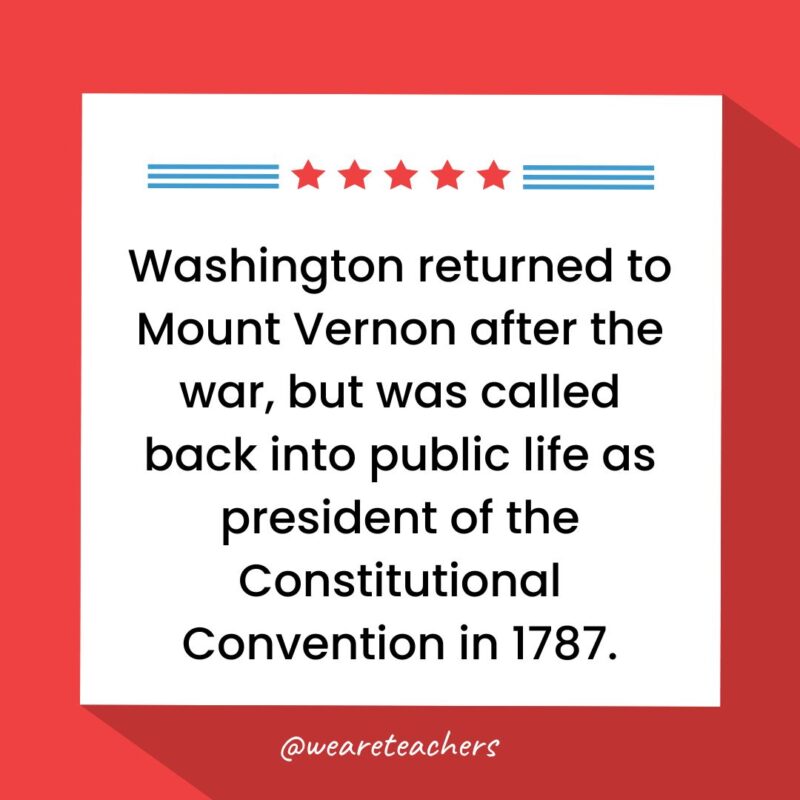
Washington believed strongly in a strong central government united under a single executive leader. His quiet leadership style nevertheless carried the day. James Monroe wrote, “Be assured, [Washington’s] influence carried the government.”
13. Washington was the only president to be elected unanimously by the Electoral College—twice.

He established the first Presidential Cabinet with four positions: Secretary of State, Secretary of Treasury, Secretary of War, and Attorney General. Washington purposely picked men to serve in his cabinet who held very different points of view on many issues. He felt it was important to hear and consider multiple sides before making any decisions, and his cabinet meetings were often full of heated debate.
14. George Washington never lived in Washington, D.C.

At the time of Washington’s presidency, the country’s capital was first New York, then Philadelphia. George and Martha had a series of residences as president and first lady. In 1790, Congress passed the Residence Act, calling for a permanent home for the capital, and Washington was heavily involved in the new city’s planning and construction.
15. Washington’s second inaugural address was only two paragraphs long, making it the shortest on record.
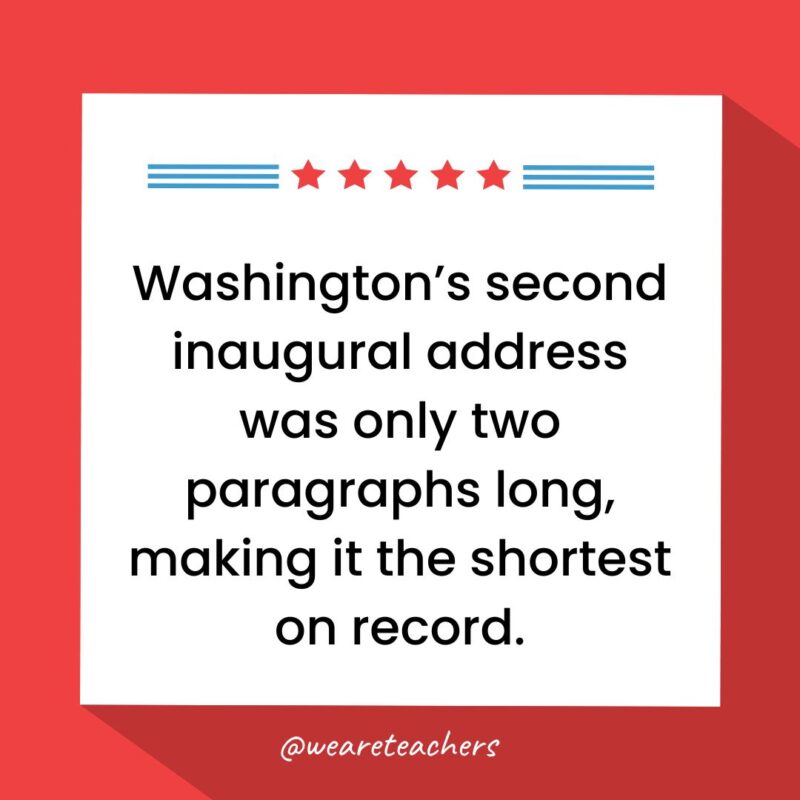
The address read, in part: “I am again called upon by the voice of my country to execute the functions of its Chief Magistrate. … This oath I am now about to take, and in your presence: That if it shall be found during my administration of the Government I have in any instance violated willingly or knowingly the injunctions thereof, I may (besides incurring constitutional punishment) be subject to the upbraidings of all who are now witnesses of the present solemn ceremony.”
16. George Washington shocked the world by refusing to serve a third presidential term. His Farewell Address warned against a deep divide between the developing political parties.
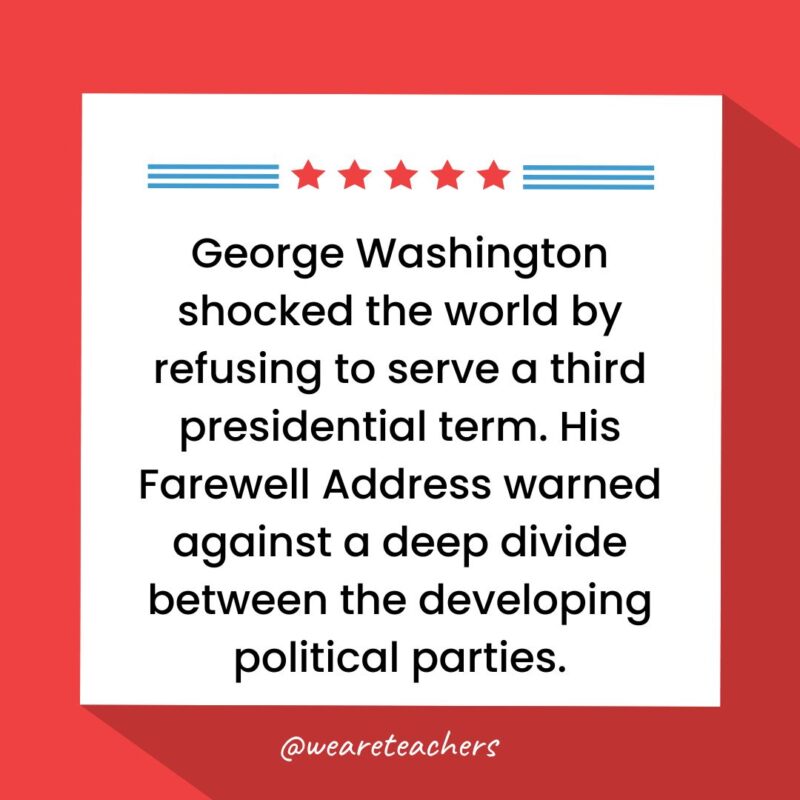
Speaker’s Notes: In his Farewell Address, Washington said, “The common and continual mischiefs of the spirit of [political] party are sufficient to make it the interest and duty of a wise people to discourage and restrain it. … It agitates the community with ill-founded jealousies and false alarms, kindles the animosity of one part against another, foments occasionally riot and insurrection. It opens the door to foreign influence and corruption, which finds a facilitated access to the government itself through the channels of party passions.”
17. Washington died in December 1799 at the age of 67 of a throat infection. He passed away and was buried at home in Mount Vernon.

Three different doctors were called in to treat Washington, but medical treatments of the time were harsh and probably hastened his death. The doctors bled him a total of four times, taking as much as four cups of blood at a time. They also “blistered” his throat and administered a cough syrup that nearly caused him to choke to death.
18. It is a myth that George Washington’s dentures were made of wood. Instead, they were made from human teeth, ivory, and silver, among other materials.

Whenever Washington had to have a tooth pulled, he kept it, hoping it could be used later to make his dentures. When he died, he had only one natural tooth remaining in his jaw.
19. The story about Washington chopping down his father’s cherry tree is a myth made up by one of his first biographers.

Speaker’s Notes: The biography was written by Mason Locke Weems and was a popular bestseller for years. Abraham Lincoln remembered reading it when he was young.
20. Though he never had children of his own, Washington is often called the Father of His Country.
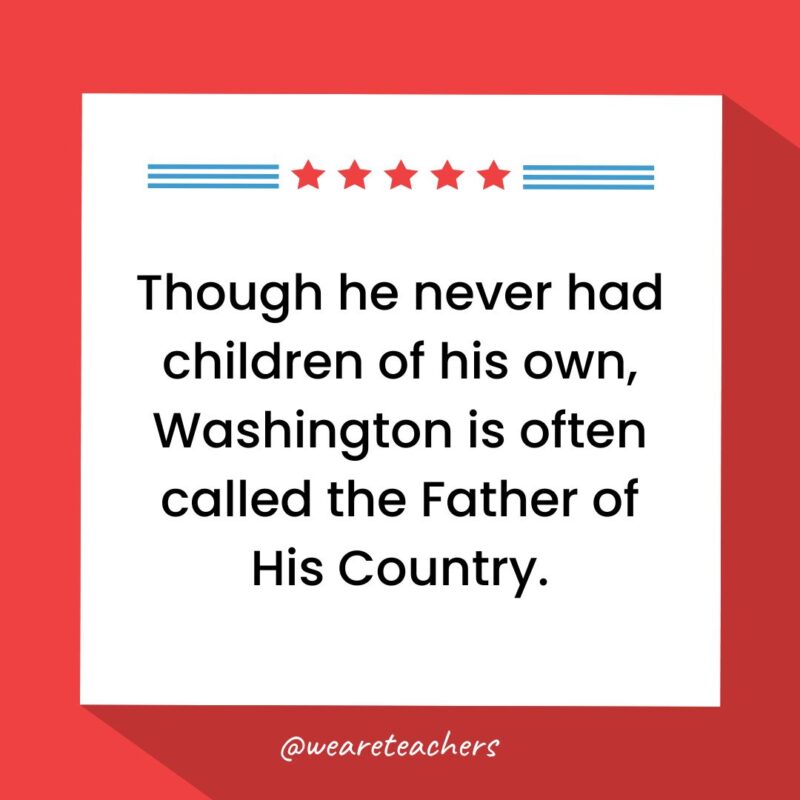
Speaker’s Notes: Washington earned this moniker as early as 1775, with Henry Knox telling him “the People of America look up to you as their Father.” The term was first used in print in 1778. Washington’s influence and leadership was instrumental in helping the 13 Colonies become one united nation.
Get your free slideshow of all the fun facts about George Washington above to share with your class!


